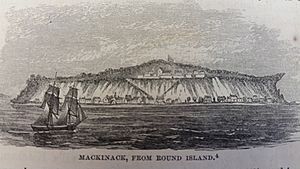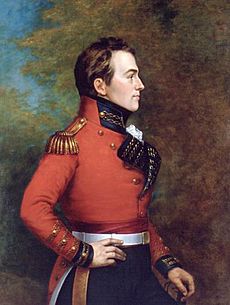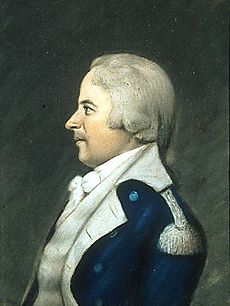Siege of Fort Mackinac facts for kids
Quick facts for kids Siege of Fort Mackinac |
|||||||
|---|---|---|---|---|---|---|---|
| Part of the War of 1812 | |||||||
 View of Fort Mackinac from Round Island |
|||||||
|
|||||||
| Belligerents | |||||||
Native Americans |
|||||||
| Commanders and leaders | |||||||
| Charles Roberts | Porter Hanks |
||||||
| Strength | |||||||
| About 600 regulars, fur traders, voyageurs and natives | 61 | ||||||
| Casualties and losses | |||||||
| None | 61 surrendered | ||||||
The Siege of Fort Mackinac was one of the very first battles of the War of 1812. In this battle, a combined force of British soldiers and Native American warriors captured Mackinac Island from the United States. This easy victory encouraged more Native American tribes to join the British side. Their help was very important for the British in many battles throughout the rest of the war.
Contents
Why Was Mackinac Island Important?
Mackinac Island was a key place for the North American fur trade. It sat in the Straits of Mackinac, connecting Lake Michigan and Lake Huron. For a long time, this island was important because it helped control the Native American tribes in the area.
After the American Revolutionary War, the island was given to the United States. British and Canadian traders were not happy about this. The United States Army kept a small fort there, called Fort Mackinac.
The Fur Trade and Native American Relations
The fur trade was a huge part of life in the area known as the Northwest. Every spring, many Native Americans from places like modern Michigan, Minnesota, and Wisconsin would gather at Mackinac. They also went to the North West Company's trading post in Sault Sainte Marie, Canada. They traded furs for goods.
The British government wanted to stay friends with the Native American tribes. British officers gave gifts to them regularly at their military post on St. Joseph Island. Many tribes in the area were already upset about American settlers moving onto their lands. When war began, they were eager to join the British and Canadians. They also wanted to launch their own attacks.
How the War Started at Mackinac
Major General Isaac Brock, the British commander in Upper Canada, knew war was coming. He kept Captain Charles Roberts, who was in charge at St. Joseph Island, updated. As soon as Brock learned that war had officially started, he sent a message to Roberts. The message ordered Roberts to capture Mackinac.
William McKay, a well-known trader, delivered the message to St. Joseph Island on July 8. Captain Roberts quickly gathered his forces. He had three men from the Royal Artillery and 47 British soldiers. He also had 150 Canadian fur traders and voyageurs (travelers). About 300 Ojibwe and Odawa warriors, who were there to trade, joined them. Another 110 Sioux, Menominee, and Winnebago warriors also joined. These warriors were recruited by an Indian agent named Robert Dickson.
Roberts received confusing orders from Brock. First, he was told to cancel the attack, then to go ahead with it again. Another officer, Colonel Edward Baynes, told Roberts to focus on defending St. Joseph Island. But on July 15, Roberts got new orders from Brock. These orders allowed Roberts to decide what to do. Roberts worried that the Native American warriors would leave if they didn't get to fight. So, he decided to attack right away. His force set out in a schooner (a type of boat), 70 war canoes, and 10 bateaux (small boats).
The Capture of Fort Mackinac
Fort Mackinac was a fort made of stone and wood walls. It sat on a limestone ridge overlooking the harbor. The American soldiers inside were 61 artillerymen led by Lieutenant Porter Hanks. They had seven cannons, but only one could reach the harbor. The fort also had weaknesses. The soldiers got their fresh water from a spring outside the fort. Also, a higher ridge less than a mile away overlooked the fort.
The American Secretary of War, William Eustis, had not sent any messages to Lieutenant Hanks for months. He sent news of the war starting by regular mail. This was on June 18. The postmaster in Cleveland, Ohio understood how important the news was. He hired a special rider to take it to Brigadier General William Hull, who was moving toward Detroit. But it was too late. Both Hull and Hanks were caught by surprise when the war began.
Hanks didn't know about the war, but he heard rumors of unusual activity at St. Joseph Island. He sent a fur trader named Michael Dousman to investigate. Dousman's boat was captured by the British force. Dousman then seemed to switch sides quickly.
Roberts learned from Dousman that the Americans at Mackinac didn't know about the war. So, Roberts's force landed quietly at a place now called British Landing. This was on the north end of the island, about 2 miles from the fort. It was early morning on July 17. They quietly moved the villagers out of their homes. Then, they dragged a cannon through the woods to a ridge above the fort. They fired one shot. After that, they sent a message asking the fort to surrender.
Lieutenant Hanks's soldiers were surprised. They were also in a bad position. Three villagers came with the surrender message. They greatly exaggerated how many Native Americans were with Roberts's force. Hanks feared a massacre by the Native Americans. So, he surrendered without a fight. The soldiers in the fort were taken prisoner. But they were released after promising not to fight for the rest of the war.
What Happened Next
The people living on the island had to promise loyalty to the United Kingdom or leave within a month. Most of them took the oath. Roberts arrested three soldiers who had left the British Army and twenty people believed to be British citizens. There was no looting. Roberts took goods from the United States storehouses and a government trading post. He also bought cattle to feed the Native Americans. The British then left their own fort at St. Joseph Island and moved all their forces to Mackinac Island.
Some of the Native Americans, like the Ottawa and most of the Chippewas, left after the battle. But at least some of the "Western Indians" (from Wisconsin and other western areas) went south. They joined the warriors with Tecumseh at Fort Amherstburg. Just the threat of their arrival made the American Brigadier General Hull give up his plan to invade Canada. He retreated to Detroit on August 3. The news of Mackinac's capture also made several Native American groups, like the Wyandots near Detroit, join the British side. Their hostility helped the British win the Siege of Detroit soon after. Lieutenant Hanks was killed by a cannon shot at Detroit. This happened shortly before the surrender, while he was waiting for a court martial.
British control of Fort Mackinac and northern Michigan was not seriously challenged until 1814. That's when a large American force tried to take back the area. However, the American force was defeated in the Battle of Mackinac Island and other battles on Lake Huron.





